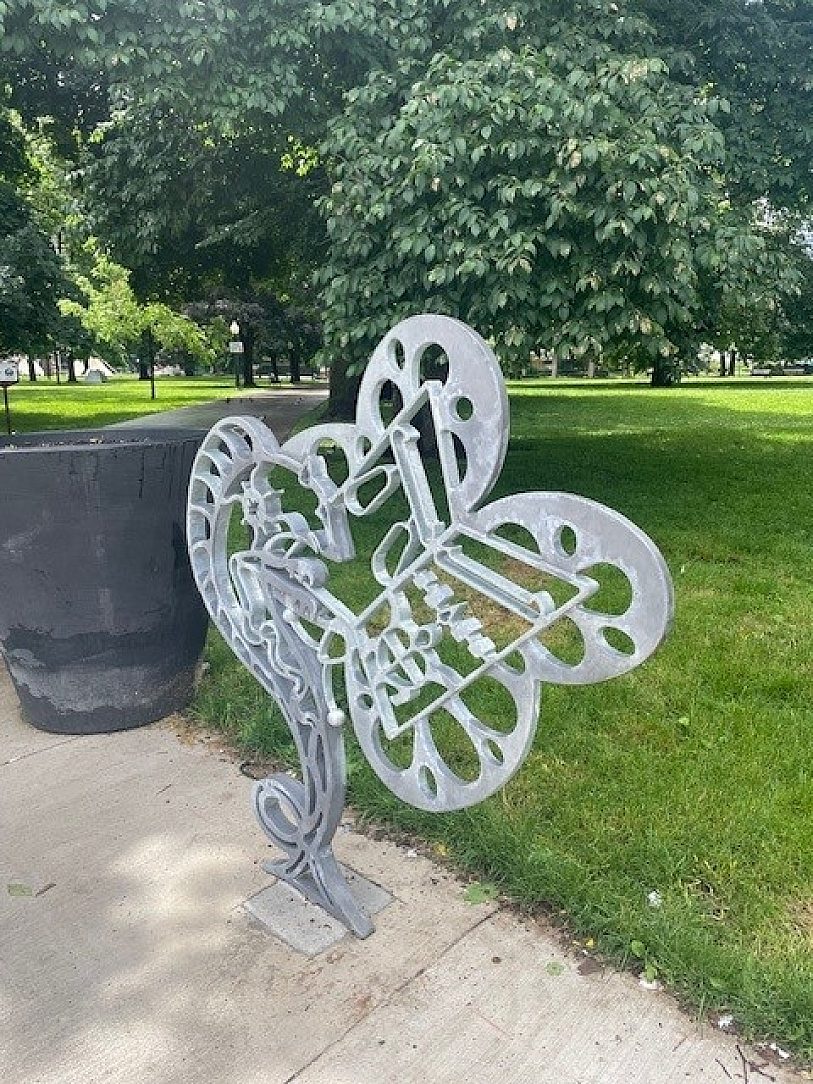Menu • Quick Links • Search
Login
CloseSitting along the street in Toronto, The Harmony, Man and Nature project brings art, function, and sustainability together through three unique bike rack sculptures crafted by Ojibwe artist Raylah Moonais. These sculptures are more than just functional street furniture; they are pieces of public art, designed to encourage bicycling as a greener form of urban transport while beautifying the cityscape. The sculpture promotes environmental awareness, while also representing indigenous artistry.
The project looks like-new after 20 years in the rough and tumble bicycle culture.
Over the past two decades, Toronto has installed more than 100 of these artistic bike racks, all conceived with the idea of uplifting neighborhoods, fostering local pride, and providing practical infrastructure for the city’s cycling community. Spearheaded by Phil Sarazen, a renowned artist and bicycle stand sculptor, he made it his life’s mission to transform the urban landscape with his unique bike stands that adorned prestigious locations in the Toronto area. Passing away in early 2024, Phil left a legacy of enthusiasm and creativity, engaging social causes and advocating for the less fortunate.
From the beginning of design conception, it was clear that conventional paint wouldn’t stand up to the demands of this project. Located in high-traffic urban areas, these bike racks face harsh environmental conditions. Whether it be city pollution or weather changes, the racks endure daily exposure to weathering, unless they are coated with a strong coating protection system: Hot-dip galvanizing.
The decision to galvanize became the clear option because of paint’s tendency to chip, peel or fade over time. In these harsh environmental conditions, the customer would be required to touch-up and maintain the structure. These constant repairs add up, costing the customer both time and money in the long run. For sculptures that need to be able to withstand the rough-and-tumble environment of urban cycling, paint would be a costly decision prone to quick deterioration.
Hot-dip galvanizing provides unparalleled corrosion resistance, which means that even after nearly 100 years, these sculptures will continue to retain their aesthetic appeal and functionality without needing costly and time-consuming maintenance. The galvanizer chosen for the project worked closely with the artists and fabricators, developing a specialized process that allowed the galvanizing to bond with the sculpture’s unique design elements, including stone inserts for added color. This approach ensured that the sculptures not only met the structural demands but also maintained the visual qualities that make them a true community treasure.
Furthermore, these sculptures were created through a collaborative effort involving marginalized community members, including people from the shelter system, who participated in the fabrication process, gaining skills and employment opportunities.
Reflecting on the durability and impact of these sculptures, one community member noted, “Looks like new after 20 years in the rough and tumble bicycle culture.” This enduring quality is precisely why galvanizing was chosen over paint, allowing the project to focus on expanding its reach and sharing the work of Indigenous artists throughout Toronto rather than dedicating resources to maintain its beauty.
For the Harmony, Man & Nature project the teams celebrate both the enduring strength of galvanized steel, and the creative vision Phil brought to the community. Galvanizing provides long-lasting protection against rust and corrosion, ensuring this installation will withstand the test of time—much like Phil’s positive impact on those around him.
Details
Award Class
Newly Complete
Award Sectors
Recreation & Entertainment
Environment
Industrial/Urban
Location
Toronto, ON Canada
Reasons for Galvanizing
Aesthetics, Coating Durability, Corrosion Performance, Initial Cost, Life-Cycle Cost, Prior HDG Experience, Quality of HDG, Sustainability, Turnaround Time
Components Galvanized
The entire three sculptures
Tonnage/Size
Steel: 1
HDG: 1
Team Members
Architect
Owner
Friends of Allan Gardens
Fabricator
BikeArts.ca
Member Galvanizer(s)
Valmont Coatings - Pure Metal Galvanizing Mississauga
Thank you! Your vote has been accepted.










